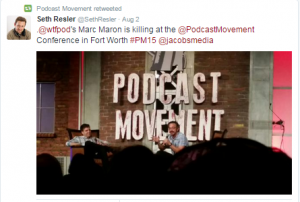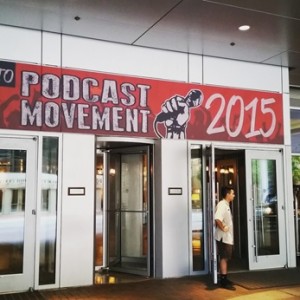 In May, when we hired Seth Resler – our Digital Dot Connector – he told us that his background, experience, and interest in podcasting would be of value to both Jacobs Media and jācapps clients. He was right.
In May, when we hired Seth Resler – our Digital Dot Connector – he told us that his background, experience, and interest in podcasting would be of value to both Jacobs Media and jācapps clients. He was right.
Seth has been deep into podcasting for five years now – and his area of interest just happens to be food. You can check out his podcast – Taste Trekkers – here.
The podcasting opportunity is growing in intensity as the radio industry is awakening to its great potential. Last week, it was Scripps buying the podcasting startup Midroll Media (which we blogged about). Yesterday, it was the big announcement that Hubbard Radio is investing a sizable stake in Norm Pattiz’s Podcast One.
Coincidence? I don’t believe in them.
We’re learning that Seth’s instincts about the web are very good. This past weekend, he made the trip to Fort Worth, Texas, to attend the second annual Podcast Movement conference. There weren’t a lot of commercial broadcasters on hand at the Omni Hotel where the conference was held. But our mission is to stay ahead of the curve, and that’s why he was there.
And here’s his “take” on the goings-on at this fast-growing conference, and its potential impact on radio. – FJ
Over the weekend, I braved the Texas heat to attend the nation’s largest conference focused exclusively on podcasting. Over 1,000 people were in attendance at Podcast Movement to learn, share, and get to know each other, illustrating the growing power of this emerging medium and the community it has spawned.
Here are my five key takeaways from this event that will hopefully help you better understand the space and where it’s moving:
 1. There are three groups of podcasters: journalists, entertainers, and coaches.
1. There are three groups of podcasters: journalists, entertainers, and coaches.
The journalists, represented by keynote speakers Sarah Koenig of Serial and Roman Mars of 99% Invisible, come from the public radio sector. With an emphasis on research, storytelling, and post-production editing, the influence of Ira Glass and This American Life on this group is unmistakable.
By contrast, the entertainers, led by keynote speakers Marc Maron of WTF and Aisha Tyler of Girl on Guy, often emphasize their lack of research and structure.
And then there are the coaches, who act as teachers, offering their listeners instructional advice in a variety of disciplines. The largest field is entrepreneurial advice, illustrated by keynoters John Lee Dumas of Entrepreneur on Fire and Pat Flynn of Smart Passive Income.
2. The energy in the room was incredible.
At Podcast Movement, the crowd was young and diverse. There was an enthusiastic exchange of knowledge between the veterans and the newbies. A recurring theme at the event was the notion that podcasters should view each other as collaborators, not competitors. In short, there was an optimism among the attendees that is often in short supply at radio conventions.
3. Commercial radio was noticeably absent.
While the public radio community had a strong presence at the event, the handful of commercial broadcasters in attendance was mostly made up of former radio employees eying this new space. Not once did I hear anyone mention any of the big commercial broadcasting companies. That’s both a problem and an opportunity for commercial radio.
In his keynote, Marc Maron — a former Air America host — said, “The one thing [podcasters] have is real numbers. Radio has been playing creative games with Arbitron for decades.”
4. Building an audience is still a huge challenge for most podcasters.
In his breakout session, Rob Walch, VP of Podcaster Relations for Libsyn, pointed out that the average podcast attracts only 158 downloads per episode. Despite the popular narrative in the mainstream press, podcasting has seen slow but steady growth, not a sudden resurgence.
It hasn’t helped that Google has not embraced podcasting with a native Android app (although I did hear rumblings of one over the weekend), so the overwhelming majority of podcast listening is more common on Apple devices.
Most of the successful podcasts have found an audience by finding a way to tap into the fanbase of others. Maron said he was conscious from the beginning that he could leverage the celebrity status of his guests to grow his audience.
Serial found its fan base by releasing its pilot episode on the podcast feed for the enormously popular This American Life. John Lee Dumas and Pat Flynn have interviewed high-profile entrepreneurs like author Tim Ferriss. Aisha Tyler had a fanbase prior to launching her podcast thanks to her roles on Archer, Friends, and Talk Soup.
This concept is what makes podcasting an ideal medium for commercial radio: stations already have an audience they can tap into, so they are perfectly positioned to succeed with podcasting.
5. Monetization strategies are continuing to evolve.
While podcasting’s reach is still far smaller than terrestrial radio’s, there is a general belief that podcasting will enable advertisers to target specific consumers with greater acc uracy. Midroll conducts a 15-question survey among the listeners of each podcast it works with, enabling them to effectively match audiences, podcasts, and appropriate advertisers. Some advertising services allow ads to be “stitched” into the audio in a way that allows them to be swapped in and out of older evergreen episodes.
uracy. Midroll conducts a 15-question survey among the listeners of each podcast it works with, enabling them to effectively match audiences, podcasts, and appropriate advertisers. Some advertising services allow ads to be “stitched” into the audio in a way that allows them to be swapped in and out of older evergreen episodes.
And many podcasters are using channels outside of advertising to generate revenue. Pat Flynn promotes affiliate links for companies like Bluehost, which give him a percentage of every sale that he generates. Marc Maron makes the 50 most recent episodes of his podcast available for free, but requires a subscription fee to listen to the back catalog.
Many people use their podcasts to promote their own products, services, or events. John Lee Dumas does all three — he’s a podcasting consultant, he’s created an online course called Podcasters’ Paradise, and he’s put together a cruise for podcasters. How’s that for “non-traditional revenue?”
Overall, Podcast Movement 2015 was a valuable event for people with any level of experience with the medium. Broadcasters should embrace the people in this community at events like Podcast Movement, the New Media Expo, and in the Podcasters Google+ community. There’s a lot to be learned.
And the potential for radio to reboot itself in the podcasting space has never been greater.
Time to move.
Contact Seth Resler here.
- A Simple Digital Treat to Thank Your Radio Listeners This Thanksgiving - November 13, 2023
- Interview Questions When Hiring Your Radio Station’s Next Digital Marketing Manager - November 6, 2023
- A Radio Conversation with ChatGPT: Part 2 – Promotions - October 30, 2023




Fascinating recap Seth. I’v been trying to understand this space better and this was a great way to help do that. Good work.
DP
Dave, there’s more coming. Seth has a great perspective on how radio can optimize the podcasting opportunity. Thanks for the kind words.
Excellent job, Seth. Clear, concise and with the flavor of podcasting’s Wild West environment similar to what existed in the early days of Internet commercialization. So much more to come.
Thanks, Jay. Yes, it does feel like the Wild West. There’s a great sense of excitement and possibility.
Wow, what a great article Seth! Thanks for the mention, it’s an honor 🙂
You’ve certainly brought a lot of people into the podcasting fold, John. I met a number of people at the conference who had taken your course.